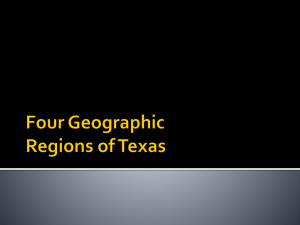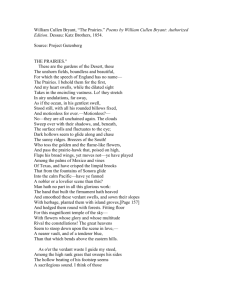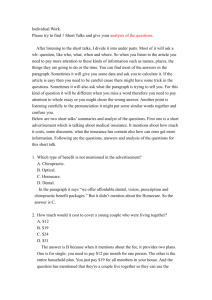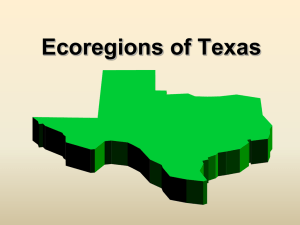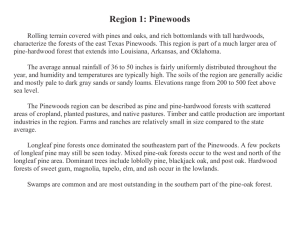Texas can be divided into the following 10 natural regions: Piney
advertisement
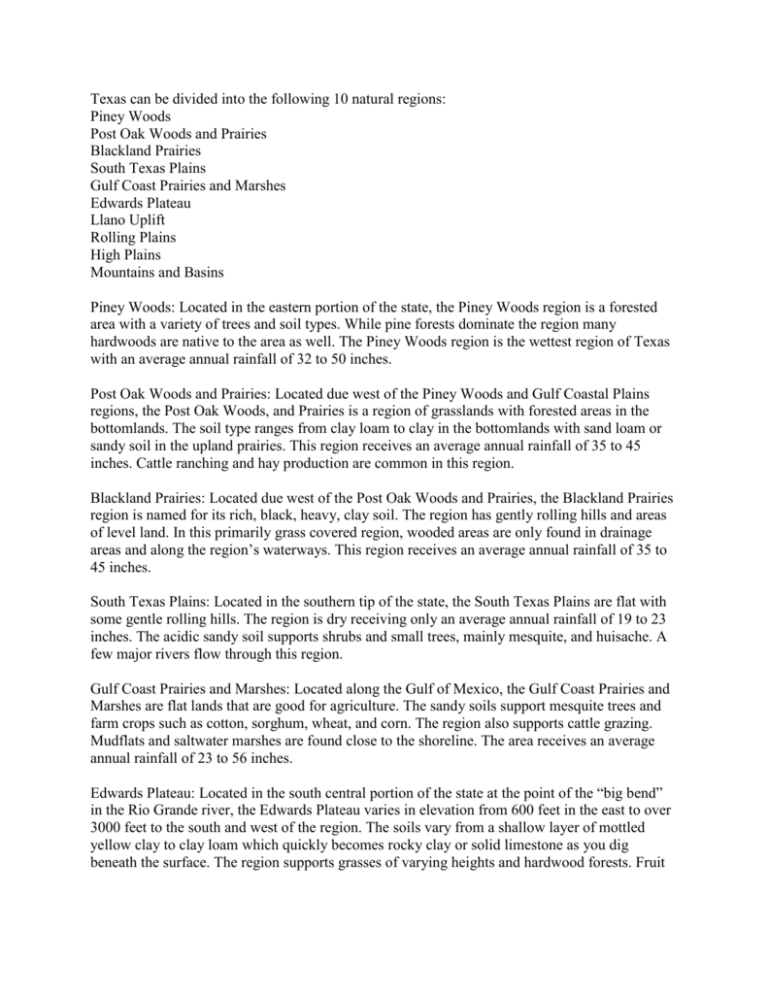
Texas can be divided into the following 10 natural regions: Piney Woods Post Oak Woods and Prairies Blackland Prairies South Texas Plains Gulf Coast Prairies and Marshes Edwards Plateau Llano Uplift Rolling Plains High Plains Mountains and Basins Piney Woods: Located in the eastern portion of the state, the Piney Woods region is a forested area with a variety of trees and soil types. While pine forests dominate the region many hardwoods are native to the area as well. The Piney Woods region is the wettest region of Texas with an average annual rainfall of 32 to 50 inches. Post Oak Woods and Prairies: Located due west of the Piney Woods and Gulf Coastal Plains regions, the Post Oak Woods, and Prairies is a region of grasslands with forested areas in the bottomlands. The soil type ranges from clay loam to clay in the bottomlands with sand loam or sandy soil in the upland prairies. This region receives an average annual rainfall of 35 to 45 inches. Cattle ranching and hay production are common in this region. Blackland Prairies: Located due west of the Post Oak Woods and Prairies, the Blackland Prairies region is named for its rich, black, heavy, clay soil. The region has gently rolling hills and areas of level land. In this primarily grass covered region, wooded areas are only found in drainage areas and along the region’s waterways. This region receives an average annual rainfall of 35 to 45 inches. South Texas Plains: Located in the southern tip of the state, the South Texas Plains are flat with some gentle rolling hills. The region is dry receiving only an average annual rainfall of 19 to 23 inches. The acidic sandy soil supports shrubs and small trees, mainly mesquite, and huisache. A few major rivers flow through this region. Gulf Coast Prairies and Marshes: Located along the Gulf of Mexico, the Gulf Coast Prairies and Marshes are flat lands that are good for agriculture. The sandy soils support mesquite trees and farm crops such as cotton, sorghum, wheat, and corn. The region also supports cattle grazing. Mudflats and saltwater marshes are found close to the shoreline. The area receives an average annual rainfall of 23 to 56 inches. Edwards Plateau: Located in the south central portion of the state at the point of the “big bend” in the Rio Grande river, the Edwards Plateau varies in elevation from 600 feet in the east to over 3000 feet to the south and west of the region. The soils vary from a shallow layer of mottled yellow clay to clay loam which quickly becomes rocky clay or solid limestone as you dig beneath the surface. The region supports grasses of varying heights and hardwood forests. Fruit and vegetable crops are commonly grown in the region. The area has an average annual rainfall of 23 to 35 inches. Llano Uplift: Located in the center of the state, this region is known for its unique minerals and rock formations of large granite domes. The elevation of the area varies from 825 feet to 2250 feet creating a hilly terrain. The coarse sandy soils support hardwoods, shrubs, and grasslands. Cattle ranching is common in this region. The area receives an average annual rainfall of 24 to 32 inches. Rolling Plains: Located in the northern section of the state just east of the High Plains region, the Rolling Plains region is fertile grassland with rough terrain. The elevation varies from 1000 to 3000 feet. The neutral to alkaline soils support a variety of vegetation from hardwoods to shrubs to grasses. Economic pursuits in this region include oil and gas production, cattle ranching, cotton, sorghum, and game hunting. The area receives an average annual rainfall of 22 to 30 inches. High Plains: Located in the panhandle, this region is part of the largest and most completely flat areas of the world. The soil is alkaline, heavy clay which supports the growth of short grasses and shrub trees like mesquite. The area receives an average annual rainfall of 23 to 35 inches. Drilling for oil and gas is the main economic pursuit in this region. Mountains and Basins: Located in far west Texas, this region ranges in elevation from 5000 to over 8700 feet. The highest mountain in the region, and in the state, is Guadalupe Peak, which reaches 8749 feet. Pine forests grow in the higher elevations with juniper and oak trees growing in the canyons. The area receives an average annual rainfall of 12 to 20 inches with a greater amount falling in the higher elevations.

